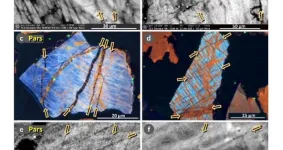(Press-News.org) A study conducted by researchers at Baylor College of Medicine and collaborating institutions reveals the molecular events leading to osteogenesis imperfecta type V, a form of brittle bone disease caused by a mutation in the gene IFITM5.
The mutation blocks the normal development of bone stem cells into mature cells, which would form healthy bones. Instead, the mutation leads to the formation of bones that are extremely brittle. Children with this disorder have recurrent fractures, bone deformities, chronic pain and other complications. The findings, published in The Journal of Clinical Investigation, offer new possibilities to design therapies for this yet untreatable condition.
“Brittle bone diseases, also known as osteogenesis imperfecta (OI), are a group of rare diseases that affect the connective tissue – tissues like bones, which support and protect other tissues in the body,” said Dr. Brendan Lee, professor, chair and Robert and Janice McNair Endowed Chair of molecular and human genetics at Baylor. He also is a member of Baylor’s Dan L Duncan Comprehensive Cancer Center and part of Texas Children’s Hospital. “Most types of OIs are caused by gene mutations that disrupt collagen synthesis or processing, but not OI type V.”
“OI type V is unique because all patients have the exact same mutation in the IFITM5 gene linked to the condition,” said first author of the work, Dr. Ronit Marom, assistant professor of molecular and human genetics at Baylor and Texas Children’s. “This mutation results in the production of a longer IFITM5 protein; however, the biological function of this protein in bone and why this mutation results in OI were not well understood.”
The researchers developed an animal model of OI type V by genetically engineering mice to express the mutant gene during certain stages of bone development. The genetically modified mice recapitulated most of the characteristics of the human condition, enabling the analysis of the underlying molecular mechanisms.
The team discovered that the IFITM5 mutation acts at the level of bone stem cells, altering the normal process that leads to bone formation. “Bone stem cells lead the way in the formation of the skeleton during development and in bone healing after a fracture – first, they give rise to cartilage, which then turns into bone,” Lee said.
The Ifitm5 mutation in mice disrupts this process. Instead of progressing from cartilage to bone, progenitor cells form overgrown cartilage calluses where new bone should be.
“Our findings help explain what we see in patients with OI type V. They not only have bones that break easily, but when stem cells attempt to heal them, they form large calluses of cartilage instead of bone,” Lee said. “It’s like the stem cells do not finish the job, they get caught in a loop to preferably form cartilage, instead of maturing into bone.”
“Until now, we considered OI to be the result of abnormal bone development. It was exciting to discover that OI type V is in fact the result of abnormal differentiation of a common stem cell, which leads to imbalance in both cartilage and bone development,” Marom said.
The team also identified two major molecular players driving this bone maturation defect. “The ERK/MAP kinase signaling pathway and the transcription factor SOX9 were both significantly increased,” Marom said. “Interestingly, when we inactivated either ERK/MAP kinase signaling or SOX9 with pharmacologic or genetic approaches, we were able to restore normal bone development in mutant models. These findings not only inform on the mechanism of OI type V, they also will facilitate the development of future therapies for this condition.”
“In addition, the fact that all the patients with OI type V have the same IFITM5 mutation could prove to be an advantage for genetic therapies directed at the mutated gene,” Lee said. “One gene therapy designed to treat the IFITM5 mutation would work for all the patients.”
This study is another example of the value of rare disease studies to improve the understanding and treatment of common diseases. “Understanding how OI type V happens provides new insight into similar but more common skeletal conditions, such as osteoporosis, and also could result in improved treatments,” Lee said.
For a complete list of the authors, their affiliations and financial support for the study, see the publication.
###
END
Bone stem cells with IFITM5 mutation get caught in a loop leading to osteogenesis imperfecta type V
2024-06-26
ELSE PRESS RELEASES FROM THIS DATE:
Tai Chi reduces risk of inflammatory disease, treats insomnia among breast cancer survivors
2024-06-26
New research led by UCLA Health confirms that both Tai Chi and cognitive behavioral therapy can reduce insomnia in breast cancer survivors but also may provide additional health benefits by reducing inflammation and bolstering anti-viral defenses.
Chronic insomnia is one of the most prominent symptoms experienced among cancer survivors and poses significant health concerns, including the risk of inflammatory disease that could increase the risk of cancer recurrence.
About 30% of breast cancer survivors are reported to have insomnia, which is twice the rate of the general population. While previous research has shown cognitive behavioral therapy and mind-body ...
Technology presented for measuring carbon in media, advertising and generative AI
2024-06-26
Measuring energy consumption derived from digital activity from a scientific point of view is the challenge faced by Hiili, S.L., a company recently formed and driven by two researchers from the Universidad Carlos III de Madrid (UC3M), Ángel and Rubén Cuevas Rumín, from the Telematics Engineering Department. Specifically, they develop technological solutions that combine Internet measurement techniques and Artificial Intelligence (AI) to make an accurate estimate of the energy consumption of a company's ...
Do people who exercise more have a lower risk of ALS?
2024-06-26
EMBARGOED FOR RELEASE UNTIL 4 P.M. ET, WEDNESDAY, JUNE 26, 2024
MINNEAPOLIS – Moderate levels of physical activity and fitness may be linked to a reduced risk of amyotrophic lateral sclerosis (ALS) later in life, according to a new study published in the June 26, 2024, online issue of Neurology®, the medical journal of the American Academy of Neurology. The study only found an association between physical activity and risk of ALS in male participants, not female participants.
ALS is a rare, progressive neurodegenerative disease that affects nerve cells in the brain and the spinal cord. People with ALS lose the ability to initiate ...
Could preventative drug be effective in people with migraine and rebound headache?
2024-06-26
EMBARGOED FOR RELEASE UNTIL 4 P.M. ET, WEDNESDAY, JUNE 26, 2024
MINNEAPOLIS – A drug used to prevent migraine may also be effective in people with migraine who experience rebound headaches, according to a new study published in the June 26, 2024, online issue of Neurology®, the medical journal of the American Academy of Neurology.
People with chronic migraine who overused pain medication had fewer monthly migraine and headache days and fewer days using pain medication when taking the migraine prevention drug atogepant.
“There is a high prevalence of pain medication ...
Pathologists awarded grant from American Society of Hematology
2024-06-26
Dr. Zhen Mei, a clinical pathologist, and Dr. Vivian Chang, a pediatric hematologist-oncologist, both at UCLA Health, have been awarded $30,000 from the American Society of Hematology to revise blood cell ranges for people with Duffy-null Associated Neutrophil Count, which is also known as Duffy-negative.
Those who are Duffy-negative, estimated to be two out of three people identifying as Black in the U.S., lack Duffy antigens on the surface of their red blood cells as a mechanism to resist malaria. This helps provide protection but ...
Revolutionizing ovarian cancer treatment with adaptive PARP inhibitor therapy
2024-06-26
TAMPA, Fla. — Ovarian cancer, often diagnosed at an advanced stage, presents significant treatment challenges because patients tend to develop resistance to conventional therapies quickly. Despite aggressive treatment, recurrence rates remain high, and managing this disease effectively requires innovative approaches. Poly-adenosine ribose polymerase (PARP) inhibitors have emerged as a treatment option, targeting specific DNA repair mechanisms in cancer cells. However, their use is often limited ...
Global consensus for sarcopenia
2024-06-26
“[...] the development of a global conceptual definition of sarcopenia signifies a new dawn for this muscle disease.”
BUFFALO, NY- June 26, 2024 – A new editorial paper was published in Aging (listed by MEDLINE/PubMed as "Aging (Albany NY)" and "Aging-US" by Web of Science) Volume 16, Issue 11, entitled, “Global consensus for sarcopenia.”
In this new editorial, researchers Ben Kirk, Peggy M. Cawthon, and Alfonso J. Cruz-Jentoft from the University of Melbourne and Western Health discuss the global societal issue of skeletal muscle loss and weakness, termed Sarcopenia. Low muscle ...
Ocean’s loss of oxygen caused massive Jurassic extinction. Could it happen again?
2024-06-26
DURHAM, NC – Researchers have discovered a clue in Italian limestone that helps explain a mass extinction of marine life millions of years ago, and may provide warnings about how oxygen depletion and climate change could impact today’s oceans.
“This event, and events like it, are the best analogs we have in Earth's past for what is to come in the next decades and centuries,” said Michael A. Kipp, an earth and climate science assistant professor at Duke University. Kipp co-authored a study published June 24 in the Proceedings of the National Academy of Sciences that measures oxygen loss ...
Shocked quartz reveals evidence of historical cosmic airburst
2024-06-26
(Santa Barbara, Calif.) — Researchers continue to expand the case for the Younger Dryas Impact hypothesis. The idea proposes that a fragmented comet smashed into the Earth’s atmosphere 12,800 years ago, causing a widespread climatic shift that, among other things, led to the abrupt reversal of the Earth’s warming trend and into an anomalous near-glacial period called the Younger Dryas.
Now, UC Santa Barbara emeritus professor James Kennett and colleagues report the presence of proxies associated with the cosmic airburst ...
Chemotherapy disrupts gut microbiome in patients with breast cancer
2024-06-26
COLUMBUS, Ohio – Chemotherapy is known to cause behavioral side effects, including cognitive decline. Notably, the gut microbiome communicates with the brain to affect behavior, including cognition.
“For the first time ever, our Intelligut Study found that the gut microbiome has been implicated in cognitive side effects of chemotherapy in humans,” said senior author Leah Pyter, associate professor of psychiatry and neuroscience with The Ohio State University Wexner Medical Center and College of Medicine. ...



